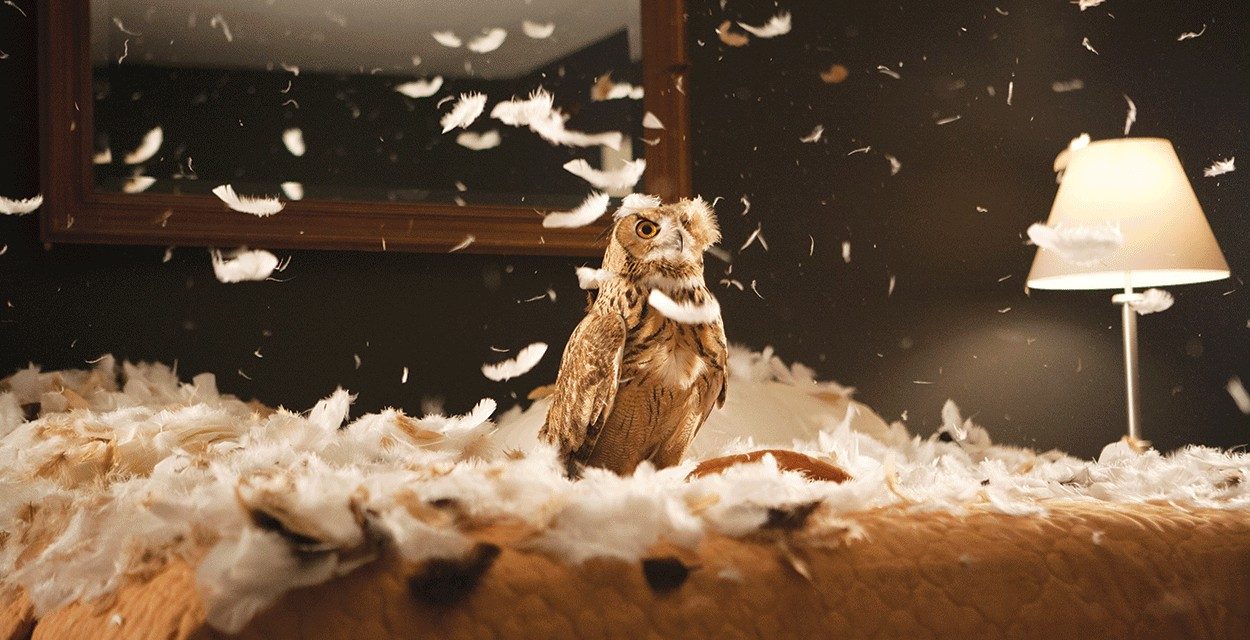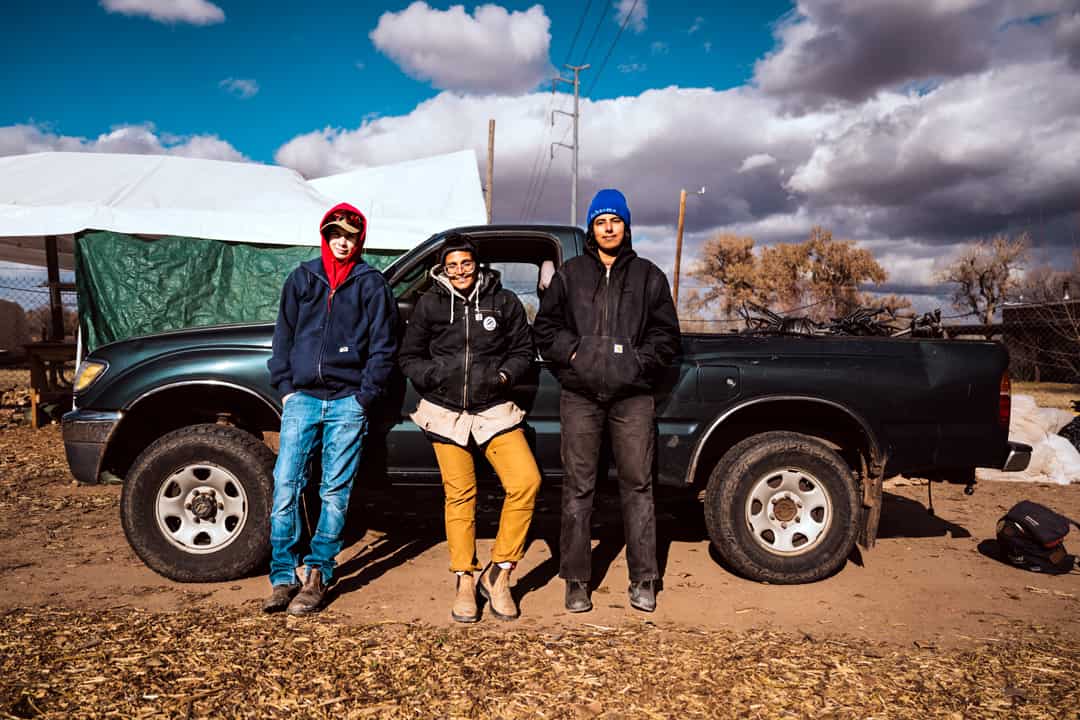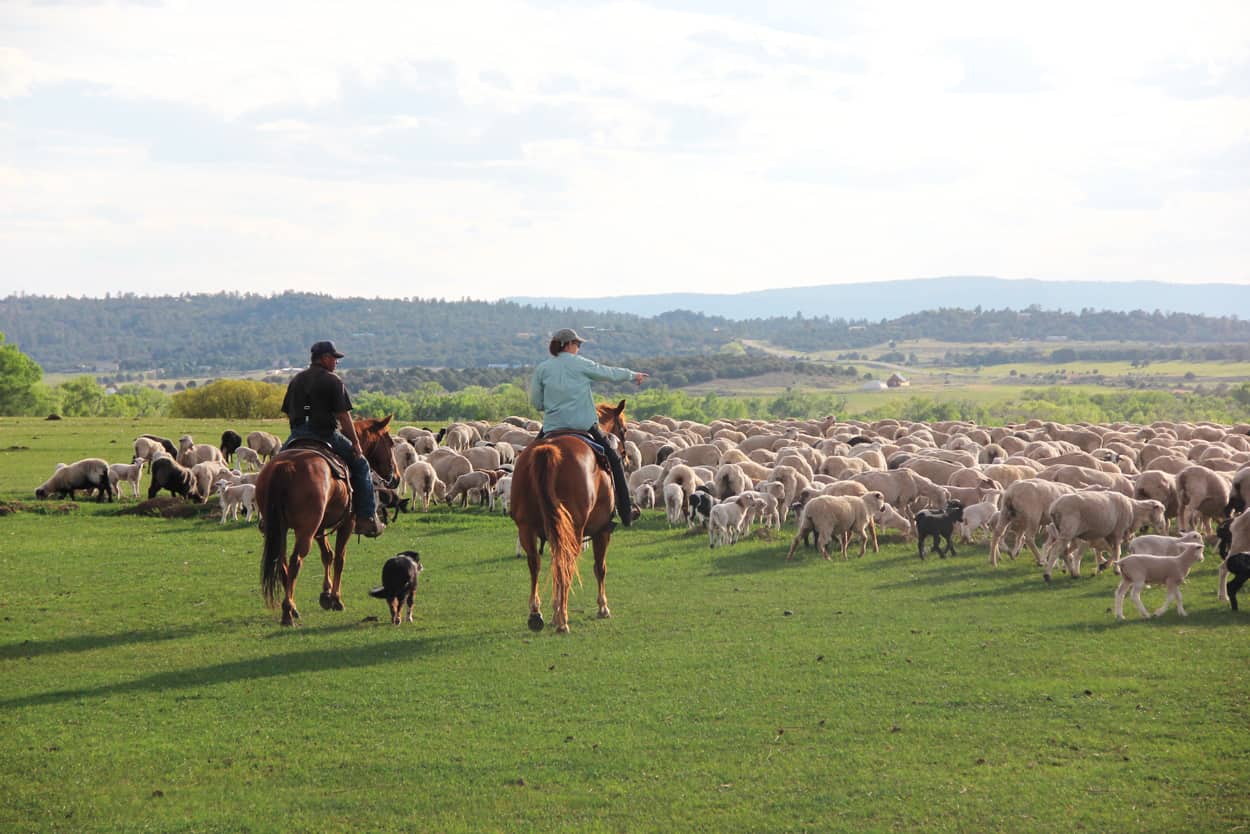Human Spaces for Wild Migrations
By Briana Olson

Doug Aitken, migration (empire), still, 2008. © Doug Aitken, courtesy 303 Gallery, New York; Victoria Miro Gallery, London; Galerie Presenhuber, Zurich; Regen Projects, Los Angeles.
The sandhill crane is not featured in artist Doug Aitken’s migration. Nor are sandpipers, snow geese, ibis, or any of the other hundreds of bird species whose migratory path aligns with the long, narrow river that is New Mexico’s lifeline. But the video installation—a haunting sequence of wild animals set in a series of budget hotel rooms—arrived at SITE Santa Fe last October, just as sandhill cranes were traveling to winter along the Rio Grande. And while the billboard-sized image of a horse pacing in front of a TV or a deer ransacking a minibar or an owl shredding a down pillow in a nondescript motel room in a nondescript industrial area is meant, clearly, to invite reflection on the strange contemporary forms of human migration, and the way human sprawl erodes animal habitat, I left the gallery thinking of wilder, more welcoming stopover sites: protected places like Bosque del Apache, wildlife refuges and open spaces that are something like extended stay hotels (breakfast included) for tens of thousands of cranes and other wintering waterfowl.
Months later, with winter and the cranes and Aitken’s installation come and gone, I head south to Socorro County to explore the intersecting foodsheds of the wild and the domesticated. I’m en route to tour two private properties that have been put in conservation along the river, but first, I take a detour and circle through the 1,700-acre Bernardo Waterfowl Management Area, part of the Ladd Gordon Waterfowl Complex. It’s a quiet June afternoon, and the only bird I sight with certainty is killdeer, running along the roadside. Yet in the croplands—green cornfields shining against unbroken blue sky—I see the promise of winter visitors, boisterous flocks of the majestic cranes whose flight paths defy the gridwork we have made of the earth, whose presence in North America predates Homo sapiens by at least 2.4 million years, and yet who have come to rely on forage (and habitat) cultivated and managed by humans.
Far from picky, the sandhill crane is an opportunist and omnivore, and will eat eggs, invertebrates, snails, lizards, rodents, and even small birds, but it leans vegetarian, and favors roots and seeds. It uses its long beak to dig for tubers and chufa nuts, and to graze on the stubble of harvested sorghum and corn. Sated, it likes to loaf in fields of alfalfa—a green it will also eat.
It is named for the Sandhills of Nebraska, near the Platte River, where the lesser sandhill crane, known to migrate from as far as Siberia, lays over in spring. The Rocky Mountain population of greater sandhills breeds in Montana’s Bitterroots or the northern reaches of the Rockies, returning summer after summer, with the same partner, to the same nest site, and winters almost exclusively along the middle Rio Grande.
“It’s important to remember,” says riparian ecologist Gina Dello Russo, that Bosque del Apache is “just a remnant and created snapshot of what used to happen all up and down the river.” Dello Russo was resident ecologist at the famed wildlife refuge for seventeen years, and is now a board member of Save Our Bosque Task Force. Historically, she says, the Rio Grande sculpted a patchwork of habitats, with flooded areas and cattail marshes where sandhill cranes fed. In spring, shallow waters would promote invertebrate bloom, attracting migratory shorebirds.
The river was last allowed to flood naturally in the 1940s, and as much as ninety-three percent of the region’s native wetlands have been lost since 1918. Dello Russo tells me that in the 1970s, the crane population at the refuge dropped to as low as seventeen. That was when wildlife managers decided to raise crops for cranes and other waterfowl—a practice that also limits damage to farmlands.
This striving for balance—mimicking vanished wetlands while protecting the economic viability of neighboring farms—is the norm, not the exception, when it comes to wildlife conservation. The word “environmentalist” might not conjure the picture of a woman driving a tractor or a cowboy driving cattle or a figure in camouflage, crouched in the predawn light, but farmers, ranchers, and hunters have contributed land and labor to form and manage protected spaces throughout the West. Also, hunting stamps and tags are an important source of revenue for state conservation efforts.
“There’s a misconception that farmers aren’t stewards of the land,” says Cecilia Rosacker, executive director of the Rio Grande Agricultural Land Trust (RGALT). The organization has worked with landowners along the river’s middle corridor to place conservation easements restricting development on twenty-three riverside properties, including the 350-acre La Joya farm that she’s invited me to visit. “Caring for the land,” she says, for a farmer, “is a matter of business.” Also, she adds, living close to the land, witnessing the “primal call of nature” that is the day’s first birdsong, the day’s first light, is part of why farmers—herself included—do what they do.
Hank Taliaferro, the La Joya farm’s owner and birder-in-chief, is running late, so Rosacker and I climb in the truck with Victor R. Saiz, the farm’s manager, who peppers his observations on the crops—teff, some sorghum, and fescue, all being raised for horse feed—with stories of his own family’s migrations. He shows us a trough they’ve cleared of invasive salt cedar (a fire hazard and threat to the soil), where, with funding from Partners for Wildlife, they’re working to construct a natural corridor. Neither Rosacker nor Saiz can help me identify the small birds fluttering alongside the river, but Taliaferro later tells me some two hundred and thirty avian species live or stop over on the property.
At one point, Taliaferro mentions that all the elk now in New Mexico descend from Rocky Mountain elk transplanted from Yellowstone. The Gila subspecies was hunted to extinction in the early twentieth century.
Taliaferro himself is a hunter. Hunting was his introduction to wildlife, and hunting is how he’s introduced his sons to the wild. When I ask how he marries his identity as a hunter with his identity as a conservationist, he runs through a list—hunting for meat, not trophies; hunting common species, like mallards, and knowing how to tell one from another; how hunting dollars contribute to conservation—before reaching what feels like his real answer. “I think it’s what makes us human,” he says, “what keeps it real.”
He also draws a straight line from his boyhood hunting to his purchase of this farm. Saiz keeps joking that farmers don’t need to gamble—farming is gambling, the saying goes—and when I ask Taliaferro about the gamble of purchasing not just a farm but one with a conservation easement, he calls it a dream, outlining concrete goals—clearing more salt cedar, planting more cottonwoods, hosting pheasant release hunting, raising vegetables, breaking even—and concludes that their progress, after six years, despite a few failures, is good. Then he mentions Annapolis, his hometown. Maryland’s eastern shore, he says, has gone from farms to a concrete jungle. “This,” he gestures at the land that surrounds the farmhouse, “is to counter that.”

Greater sandhill cranes and snow geese at Bosque del Apache. Photo by Stephanie Cameron.
An hour later, standing with Rosacker and Chuck Muncy on a lookout point on Muncy’s 500-acre ranch—also placed in conservation through partnership with RGALT—I have a breathtaking view of the river curving north, bordered with a vibrant green cottonwood gallery. Muncy points at houses scattered on the horizon, and tells me none of that was there when he was growing up. As we pile back into his truck and drop down toward the riverbank, Muncy talks about his late father, a fit, hardworking man who bought this land in 1974, and recalls how together they dug the wells and put in two windmills.
Near the river, he points out some shrubs whose berries, he thinks, songbirds eat. “Wolfberry,” Rosacker says. Sandhill cranes, I learn later, also eat their fruit, and somewhere on this stretch of river, there’s a roost, a shallow site where wintering cranes come for the night, but Muncy admits he hasn’t seen it. He also admits to having had reservations about the easement at first, but says he warmed to it once he realized this was what he wanted to do, and where he wanted to be for the rest of his life.
Thunderclouds loom above the ranch’s uplands as we head out, and the conversation turns to weather, the hope of rains both for Muncy’s rangelands and Rosacker’s farm, then circles back to a subject Rosacker and I discussed earlier: the SunZia Southwest Transmission project. Near the Escondida bridge, she points at open sky above the river that, if the project’s permits are approved, will be crossed with two 500-kilovolt transmission lines, carrying electricity from eastern New Mexico to Arizona. The proposed river crossing lies between Bosque del Apache, the Ladd Gordon complex, and the Sevilleta refuge—square in the middle of the Central Flyway. Naturally, Rosacker is concerned about bird deaths and environmental impacts of the lines, but she’s also worried about the viewshed.
By the time I’m back on I-25, it’s dark, and the rain has started. When I approach Albuquerque, my mind turns to Valle de Oro, a site that operated as Price’s dairy through the 1980s, now the first urban wildlife refuge in the Southwest. It’s easy to see a parallel between the surrounding neighborhood and the industrial locations of the motels where animals are caged in Aitken’s video; Mountainview contains thirty-two of Albuquerque’s thirty-six EPA-regulated industrial sites, and South Broadway is lined with salvage yards, old RVs and cars waiting to be picked of their usable parts. But this isn’t some strange fictional landscape where deer have been reduced to scavenging motel minibars; it’s a neighborhood whose community came together when these 570 acres went up for sale, determined to preserve the open space, for themselves and for wildlife.

Left: Wheat paste murals by activist-artist Chip Thomas, inspired by a crane dance performed at Valle de Oro, photo by Briana Olson. Right: Sandhill crane, photo by Stephanie Cameron.
In June, when I visited Valle de Oro, deputy refuge director Katie McVey had stayed late the night before, using flood irrigation to fill the refuge’s first playa, and as we skirted the broad, shallow pool, stooping to admire a pair of iridescent tiger beetles, she chatted excitedly about the woodhouse and spadefoot toads that had come out to enjoy the midnight water. A playa is a type of intermittent wetlands, and McVey explained how when it goes dry, toads crawl deep into the playa’s cracks, seeking moisture. Their presence, she said, is one marker of a healthy ecosystem. So is milkweed, a native plant (and food for butterflies and other pollinators) that McVey excitedly pointed out.
Before my visit, I’d asked about birds at the refuge, hoping to catch the tail-end of spring migrations. By drawing my attention to other species, McVey means to emphasize the intricacy of an ecosystem. In the end, it’s not all about the cranes. At Valle de Oro, in fact, the transition from alfalfa and fescue to wetlands and upland habitat, once completed, will mean fewer wintering cranes, who will instead be drawn to Candelaria Farms—a plan also meant to divert larger birds from the nearby airport and air force base. Clearing non-native species, building wetlands, and planting native willows and cottonwoods will support a variety of year-round and migratory wildlife, including western kingbirds, sandpipers, and American pipits (check ebird.org for recent sightings). A saltgrass meadow swale, sustainable alternative to concrete drainage, will run diagonally through the refuge. On September 29, their inaugural Build Your Refuge day, staff and volunteers will work on Valle de Oro’s first public trail.
The goal, McVey says, is “habitat diversity, species diversity, for a diverse audience.” It’s the first refuge she knows of to have an environmental justice strategic plan, and in keeping with the US Fish and Wildlife Service’s goals for the new urban wildlife refuge program, Valle de Oro aims to engage people who haven’t been exposed to the wild, and who might be more comfortable indoors than out. McVey is particularly proud of the involvement of school groups and the Rocky Mountain Youth Corps. “Instead of a pipeline,” she says, “we say we’re building a job acequia.” Already, one military veteran who volunteered at the refuge has landed a position at Sevilleta.
McVey envisions Valle de Oro as a “gateway to other spaces, to other opportunities for recreation,” goals to be achieved by connecting the refuge with existing paths in the bosque, but, most of all, as “a gateway to a deeper connection with nature.”
The sandhill crane is called an umbrella species—one that is so widely loved that many rallied to protect it last century, when its numbers dwindled—because its protection has resulted in protections for other, lesser known species. In more than one indigenous tradition, the crane is a peacemaker.
Edible celebrates New Mexico's food culture, season by season. We believe that knowing where our food comes from is a powerful thing. With our high-quality, aesthetically pleasing and informative publication, we inspire readers to support and celebrate the growers, producers, chefs, beverage and food artisans, and other food professionals in our community.












